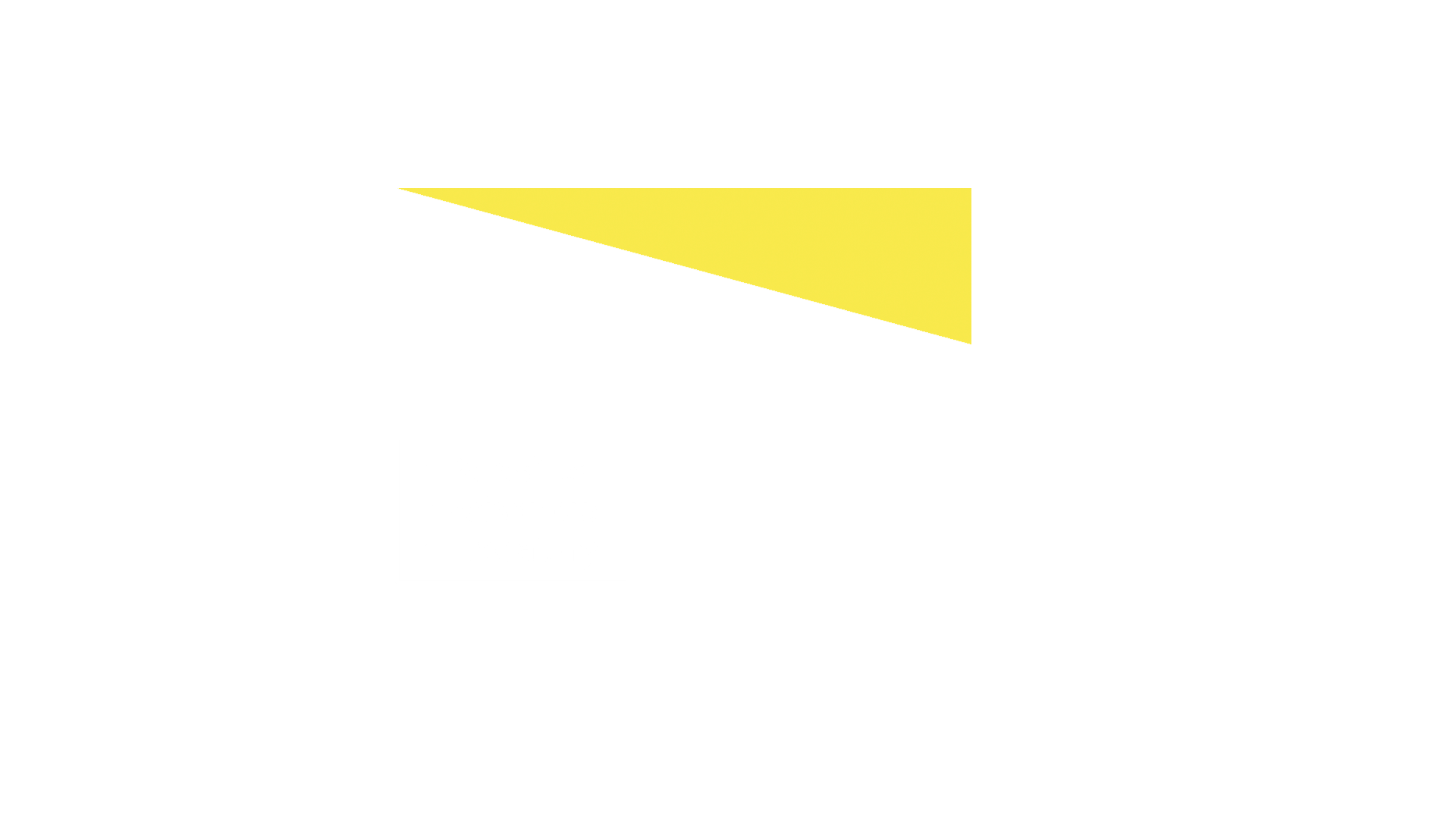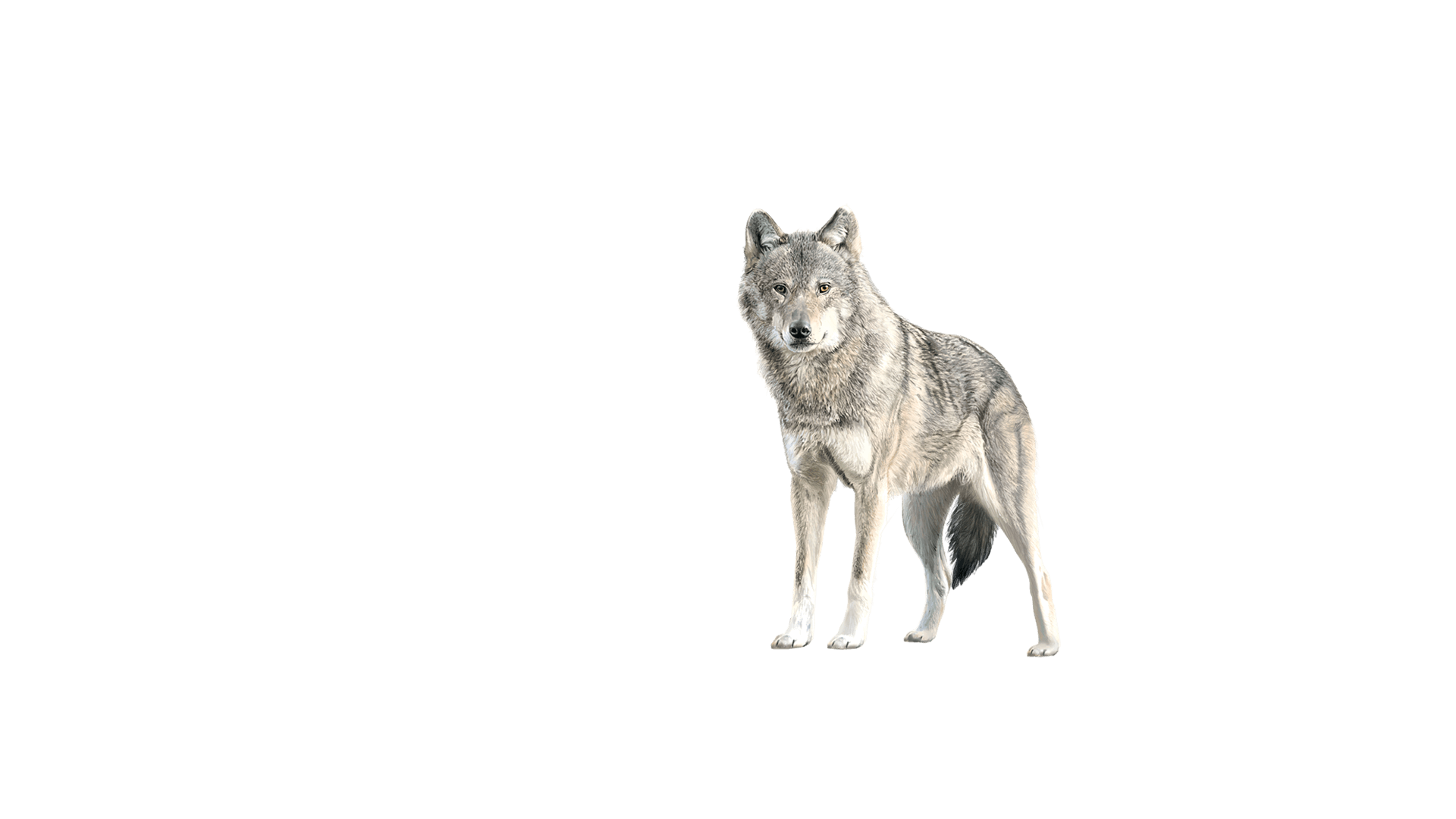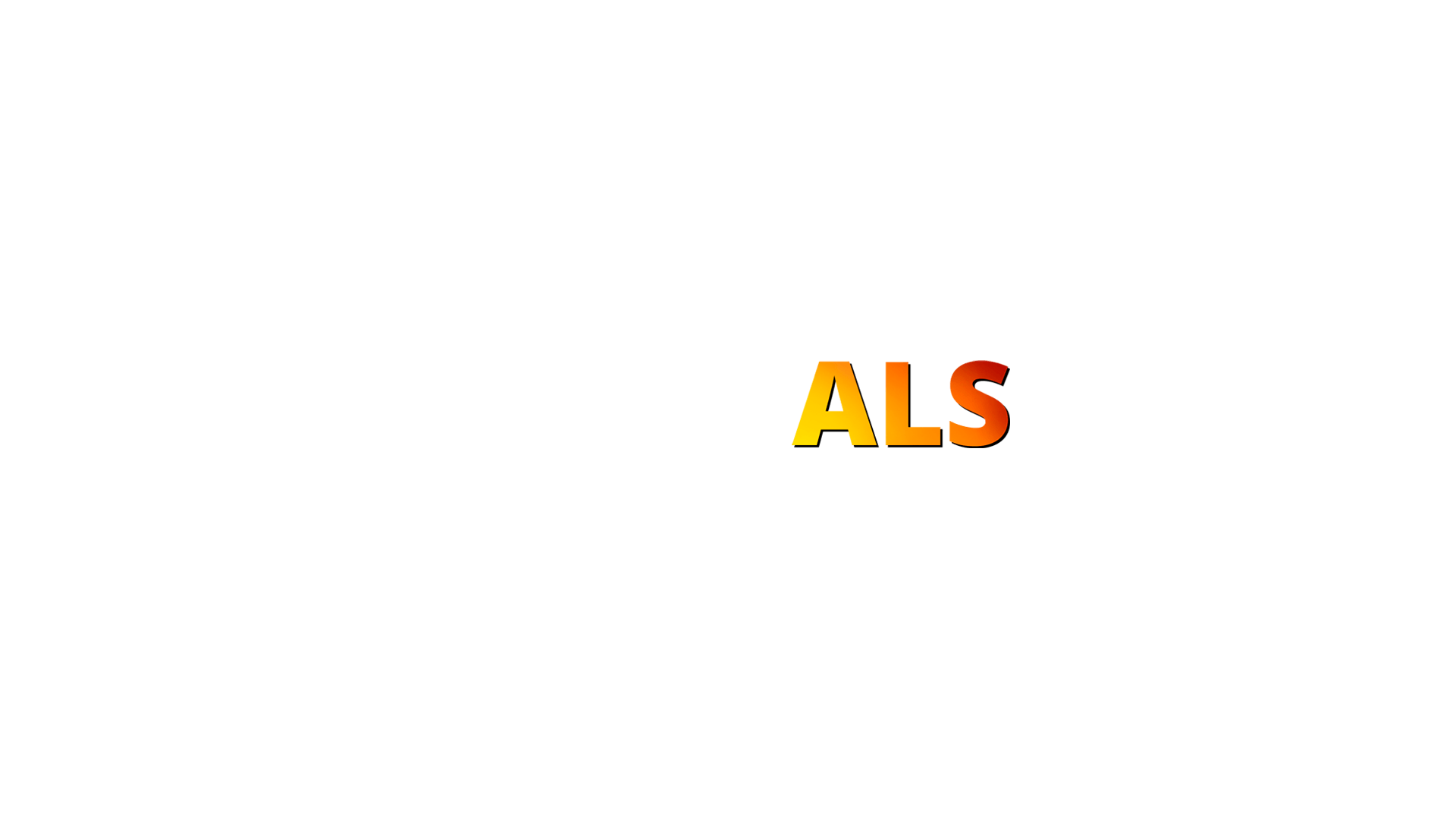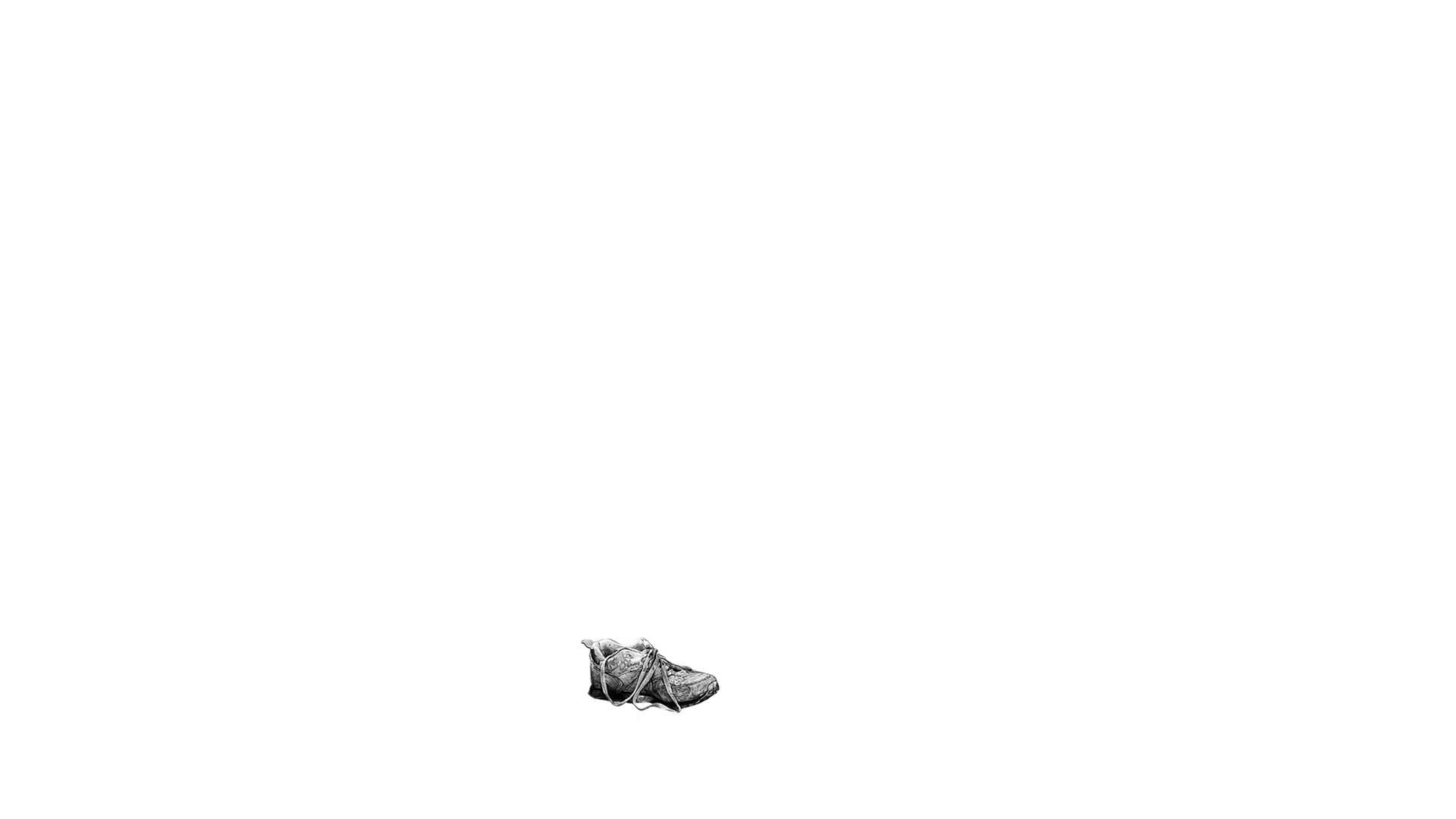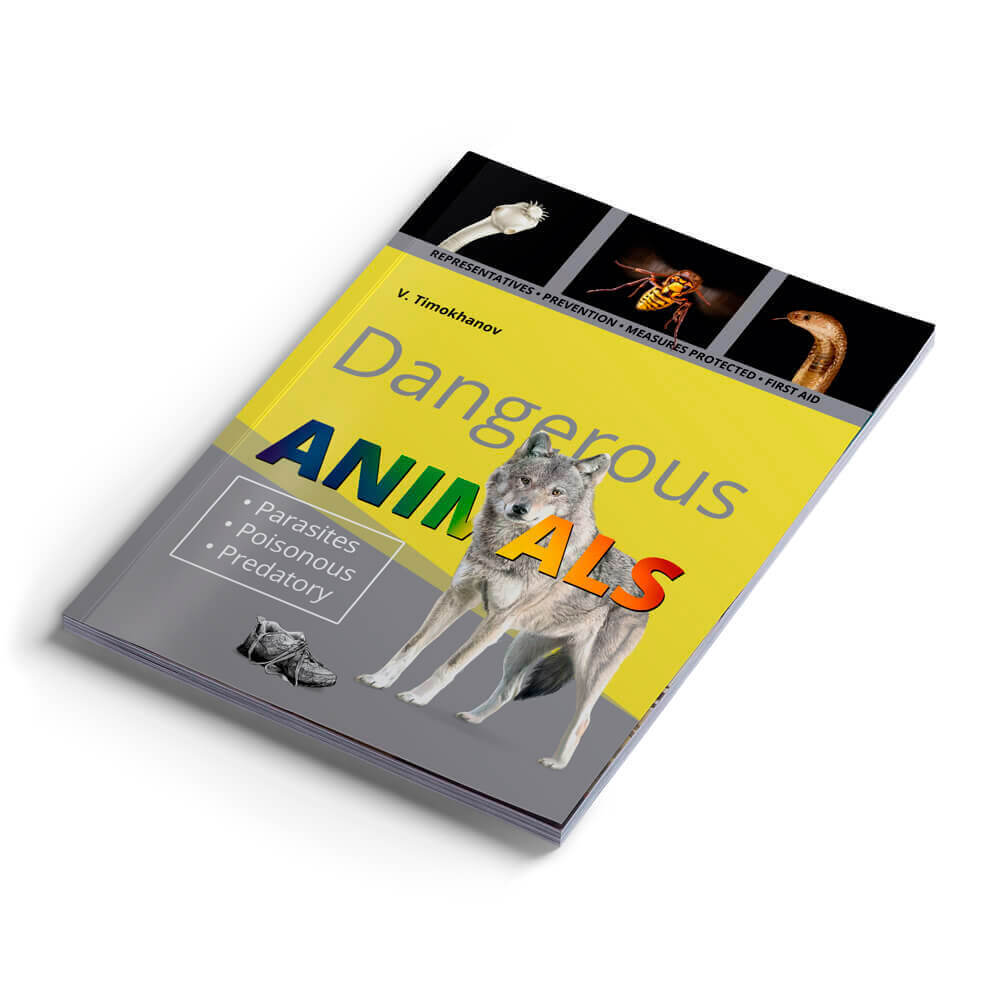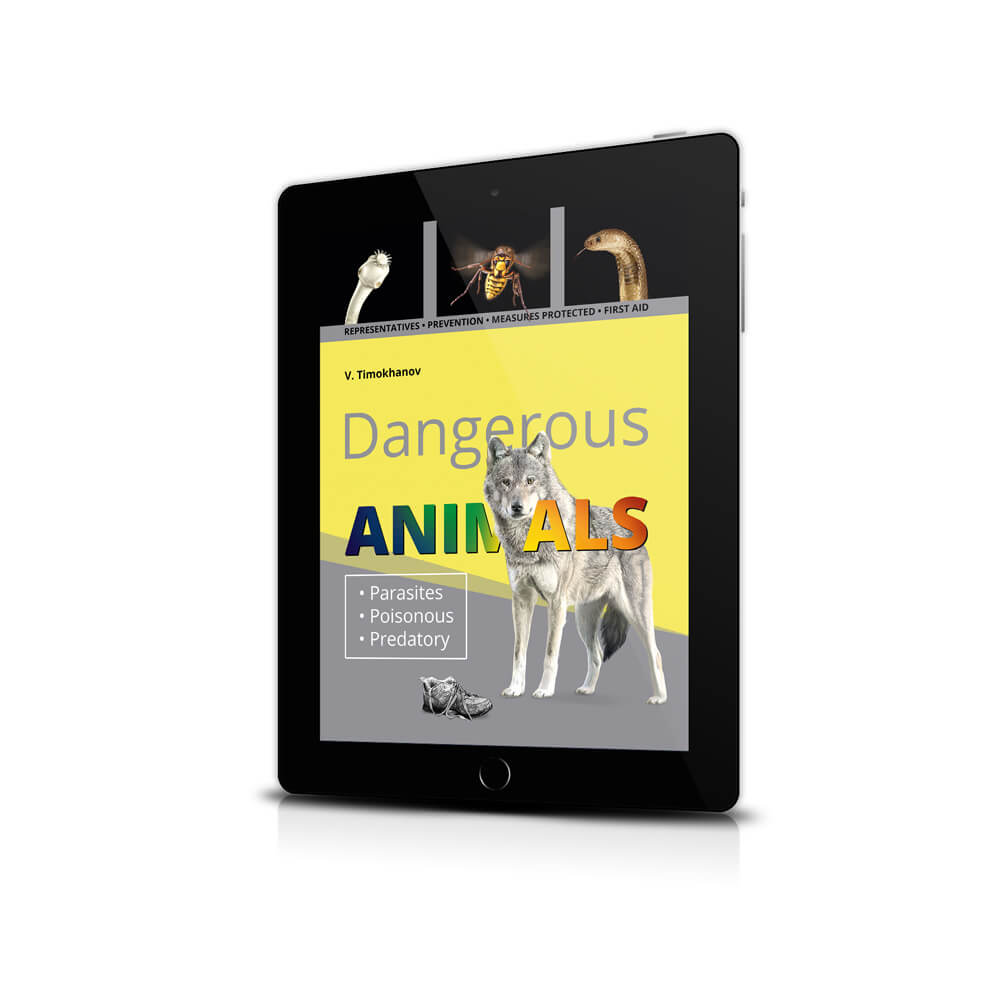DANGEROUS ANIMALS
In English and Russian.
Digital and print editions,
120 pages, 535 colour illustrations
About this book
This book is about the parasitic, poisonous, and predatory animals of Eurasia that pose a danger for people. It contains 535 illustrations of 280 species of animals and recent scientific information about them. You will find the information on animal's morphology, biology, ecology as well as their impact on humans, the degree of danger, protection, first aid and the prevention of diseases, that caused by them. The book is illustrated with a large number of colorful, scientifically true fine drawings, proved by scientific experts. This book is good illustrative guied for students, edicational organisations and broad audiences.
Digital drawings, text and book design
Adobe Photoshop
Graphic the tablet
Adobe InDesign
Pinnacle Book Achievement Award — Best Book in the Category of ANIMALS, NABE Winter 2023

2023 International Book Awards — Finalist in the Category of Animals/Pets: General


CONTENTS
Foreword
PROTOZOA
HELMINTS
MARINE INVERTEBRATES
ARACHNIDS
MYRIAPODS
INSECTS
FISH
AMPHIBIANS
REPTILES
MAMMALS
PETS
Index of Latin SpeciesNames

The world of invertebrates is amazing and striking by its diversity. It includes protozoa and helminths, sponges, jellyfish and corals, dangerous parasites and amazingly beautiful mollusks, sea urchins, starfishes, and many other unusual and mysterious living
things. Great majority of animals that inhabit the globe are invertebrates. They present everywhere — in fresh water, in the seas and oceans, on the land and even in the depth of the ground as important part of the soil. Many of them are parasites of other animals and plants, possess a poison and can pose a real danger to humans.
Life cycle of Ascaris lumbricoides

Eggs of Ascaris lumbricoides
Ascarididae
Ascaris lumbricoides
It is a large roundworm. The length of the male is up to 25 cm, the female is 40 cm. The eggs are 60 microns long. It most often affects the organs of the gastrointestinal tract. It parasitizes only in humans. The causative agent of ascariasis is the most common helminthiasis distributed throughout the globe. The larval stages of the parasite cause allergic reactions of the body, affect the tissues of the lungs and liver; mature stages inflict disorders of the digestive, nervous, reproductive systems, in severe cases, blockage of the intestinal lumen by a ball of ascaris. Diagnosis is based on the detection of eggs in feces. Prevention is identifying infested persons and conducting deworming, strict hygiene, thorough washing of vegetables, fruits, berries, and protecting food from insects.


Cyaneidae
Lion's mane jellyfish (Cyanea capillata)
The diameter of the dome is 50–60 cm, sometimes it is up to 2 m. It lives in all the northern seas of the Atlantic and Pacific oceans in the surface layers of water near the coast. Cyanea is a predator, their long numerous tentacles are seated with stinging cells, while fired a strong poison penetrates the victim’s body, that kills small animals and causes a damage to larger ones. In case of contact with the tentacles of Cyanea occurs a burning pain after a few seconds, but after 10–20 minutes appear skin lesions (erythema) and sometimes swelling persists for up to two days. The treatment is symptomatic.


Rhizostomatidae
Barrel jellyfish (Rhizostoma pulmo)
It mainly lives in the Black and Azov Seas. It has a dome up to 50 cm in diameter. Rhizostoma pulmo is a predator that eats small fish, worms, and crustaceans. Jellyfish paralyze their prey with the help of the toxic peptide rhizostomine and after successfully eat it. Touching its mouth blades causes burns, irritation of the skin and eyes.



Sepiidae
European common cuttlefish (Sepia officinalis)
It lives in the Atlantic Ocean and the Mediterranean Sea. The body length is 20–30 cm. The grasping tentacles are the same length and have 4 rows of suckers. This is what people usually eat. It stays near the bottom, hides on the ground, throwing sand or silt on its back and changes the coloration of the back in accordance with its color of the sand. It attacks from ambush small crabs, shrimps, fishes. Biogenic amines and toxic proteins are found in its venom.

The fauna of arthropod in Eurasia is rich and diverse. Although the vast majority of its representatives are harmless, but some species of arachnids, centipedes and insects can be harmful and pose a real danger to human health and even be life threatening. Meeting them is not so rare due to their abundance and wide range of habitat distribution. These species are able to bite, sting, poison with venom, cause various diseases. Often ignorance and poor awareness exaggerate the real threat and consequences of contacts with such arthropods. According to the erroneous stereotypes absolutely harmless representatives of the fauna are often regarded as poisonous and dangerous species, and incorrect actions during treatment can cause more harm than the real consequences caused by animals.
Euscorpiidae
Euscorpius italicus
The body length is about 55 mm. It lives in the Middle East, the Caucasus, Transcaucasia, North Africa, South-Western Europe, and Southern Europe. It is distributed from Sochi to Batumi along the narrow coastal forest belt of the Black Sea. A coloration varies from reddish brown to dark brown.
Euscorpiidae
Euscorpius tauricus
The body length is 35–40 mm. It can be found in the southern coast of Crimea. Usually, its stinging is harmless to people, except the fact, that they are unpleasant and painful.






Galeodidae
Galeodes caspius
The length is 45–55 mm. It is found on the territory of Kazakhstan and Uzbekistan; it prefers clay deserts. As many of Solifugae, it is completely non-venomous, although a bite can be painful. Large individuals are able to bite through human skin till it bleeds.
Theridiidae
Mediterranean black widow (Latrodectus tredecimguttatus)
Females (9–17 mm) are larger than males (3–6 mm). It is distributed from the Canary Islands to China in desert and steppe regions. Only female can pose a danger. It is difficult to notice the bite site; have no obvious painful symptoms at first, but after a few minutes can be felt severe pain throughout the body, nausea, vomiting, and shortness of breath. Lethal outcomes of humans and farm animals have been reported. In case of bitten it is necessary to administer first aid.
Lycosidae
Lycosa praegrandis
The body length of the male is 18 mm; the female is about 30 mm. It is distributed in deserts and semi-deserts from Greece to Kazakhstan. I t is an active at night, moving on the ground in search of prey. It usually does not burrow deep holes. During the day it hides under stones or other objects.
The chelicerae of Solfugae do not have any post-mortem poison since they only have live prey in their diet, and it is thoroughly cleaned after a meal.
Antivenom is used for treatment. Intravenous administration of novocaine, calcium chloride and magnesium hydrosulfate also gives good medical results. Concerning individual protection measures it is recommended to use an anti-mosquito canopy in the field, which protects at night from the penetration of karakurt. The bite site can be burned with the head of flammable match, because the spider bites through the skin with its chelicerae to a depth of only 0.5 mm, and the poison that has not had time to be absorbed is destroyed by heating. It should be done no later than 2–3 minutes after bitten.
Male
Female

Pisauridae
Hobo spider (Eratigena agrestis)
The body length of the male is up to 10 mm; the female is up to 15 mm. It is distributed in Europe, Asia, and North America. They live in settlements, building funnel-dens in the corners and cracks of walls and fences. They are not dangerous to humans, but their bites can be quite sensible.




The front legs are equipped with claws that securely cling to people and animals passing by
Sarcoptidae
Itch mite (Sarcoptes scabiei)
It is an intradermal parasite, that can cause contagious disease — itchiness. The length of the male is up to 0.23 mm, the female is up to 0.45 mm. They suck blood. Females gnaw long winding passages in the skin and fill them with eggs and feces. In case of itching, it is necessary to have an urgent appeal to a doctor, who will prescribe the appropriate treatment, which consists of the using of special ointments. Personal hygiene has a great importance for the prevention of the disease.
Pyroglyphidae
Dermatophagoides pteronyssinus
The length can vary from 0.1–0.5 mm. It is distributed over the globe. There are about 200 species of house dust mites. They inhabits human dwellings and can cause allergic reactions. They live in mattresses, carpets, etc. The life cycle is 65–80 days. They feed on dead skin cells. This type is one of the most common cause of asthma. Methods of controlling are air cleaners.
Ixodidae
Dermacentor marginatus
The body length is 3.5–5 mm. It can be found in the steppes and forest-steppes of the European part of Russia, Transcaucasia, Kazakhstan, in the mountains of Central Asia, and in the south of Western Siberia. Ticks of this genus are carriers of pathogens of tick-borne North Asian rickettsial disease, Omsk hemorrhagic fever, and in some places — tick-borne encephalitis. They are carriers of plague, tularemia, Q fever, brucellosis and canine piroplasmosis.
Scolopendridae
Megarian banded centipede (Scolopendra cingulata)
It is found in the south of the European part of Russia and in the Mediterranean countries. It reaches 100 mm in length. A coloration can vary. Usually their dorsal side is painted in a dark or olive-brown color, but also can be specimens with a lighter color. It is an active nocturnal predator. Its bites are painful and can cause a general malaise. A burning pain at the bite site is accompanied with swelling develops, chills and weakness, that last about two days. The bite does not cause dangerous consequences.
Scutigeridae
House centipede (Scutigera coleoptrata)
The body length is 20–50 mm. It is widely distributed species. It has 15 pairs of legs and antennae. The Scutigera coleoptrata bite is not dangerous for a human, as far as their maxillipeds cannot pierce human skin. In many southern countries they are welcomed as they eat harmful insects in the houses.
Cimicidae
Bed bug (Cimex lectularius)
The body length is 4.8–8.4 mm. An external parasite of humans and warm-blooded animals. It is distributed all around the globe. It has a strongly flattened body is the result of parasitism. It suck on human blood. Owing to the injection of saliva into the skin the bites can cause discomfort and irritation of the skin, possibly 500 or more bites in one night. It settles in human dwellings, in chicken coops, vivarium, dovecotes, sometimes in nests of birds, bats, and rodent burrows. Males, females, and their larvae are bloodsuckers. It leads a nocturnal lifestyle. It emits a pungent and unpleasant smell, that excreted by the secretion of odorous glands. Females lay up to 5 eggs per day, in total during their life — from 250 to 500 eggs, the life cycle is up to 15 months. It is possible, but not fully studied, that bed bugs can be carriers of any infectious diseases. In the absence of wings bedbugs are able to move through the air, climbing onto ceilings and walls and gliding from them. Methods of controlling are chemical and physical; thus, they can be deprived of shelters and places for laying eggs.

Adult insect



Eggs
Larva

Chrysomelidae
Colorado potato beetle (Leptinotarsa decemlineata)
The body length is 9–12 mm. It is common on nightshade family. It is a dangerous potato pest. Its homeland is considered to be the west of North America. The hemolymph of the beetle is poisonous to invertebrates and vertebrates. After collecting beetles and their larvae process, it is recommended to wash hands thoroughly and use gloves to protect potatoes from their poisonous hemolymph.
Many other types of leaf beetles (especially those with bright warning colors) also have poisonous substances that can cause dermatitis, though it is better to avoid contact with them.

Case-bearing clothes moth

Common clothes moth

The moth caterpillars in their cocoons
Tineidae
Common clothes moth (Tineola biseliella) and case-bearing clothes moth (Tinea pellionella)
are the most famous species of the genus Tinea, whose representatives can be found in apartments, grocery stores, museums, where they feed on food products, woolen and fur products, books. A harm to the economy is caused only by moth larvae - caterpillars. The wingspread is about 30 mm. Caterpillars live in a portable case and gnaw on everything, whether they eat up it or not. Methods of controlling them are chemical.
Vespidae
European hornet (Vespa crabro)
It is one of the largest and most dangerous wasps in Eurasia. The length of the females is up to 35 mm. It is distributed throughout Europe, except for the northern regions. It is relatively non-aggressive, but hornet stabs are very painful and, in case of being allergic to wasp venom, they are life-threatening. A large number of stabs (for example, it the nest was disturbed) can lead to of a person death.


Vespidae
German wasp (Vespula germanica)
The body length is 12–20 mm. It can be found throughout Eurasia. As most of eusocial wasps, before the attack, it first warns the offender by hitting him with its forehead several times. After that it sprays with droplets of poison with an alarm pheromone and only after the wasps of the entire nest fly at the victim. Their multiple stabs can lead to the lethal outcome.




Vespidae
Polistes sp.
The body length is 14–23 mm. Representatives of the genus are widespread and often make their nests in attics and under the roofs of human buildings. Their mass attacks are dangerous, especially if their nest is damaged.
Formicidae
Pharaoh ant (Monomorium pharaonis)
The body length is 2–2.5 mm long. It is distributed throughout the world. It is able to penetrate everywhere and spoil all products. Their presence in hospitals is quite dangerous, as they can be mechanical carriers of diseases. Penetrating into operating rooms the can disrupt a sterility. Method of controlling is a fumigation.
Pharaoh ants make their nests in all sorts of voids and other inaccessible places.
Fleas regard to the group of wingless blood-sucking insects. Adults are external parasites (ectoparasites) of warm-blooded animals. It is distributed all around the globe. Amplification is observed in late summer and autumn. There are known about 2000 species of fleas, of which up to 30 species parasitize the body of domestic animals and humans. Human fleas, dogs and cat fleas and fleas of the Vermipsyllidae are more dangerous to humans. Pulicosis and tungiasis are diseases that caused by fleas.

Female

Pulicidae
Human flea (Pulex irritans)
The body length is 3–4 mm. It can jump up to 32 cm. It is an external parasite of humans and dogs; it can be passed to other animals. It is a main carrier of the plague pathogen; and intermediate host of some animal helminths, that can be found in humans.
Male

Larva


Eggs
Pupae


The head of male
The head of female

Egg
Culicidae
Malaria mosquito (Anopheles maculipennis)
The body length can be from 8 to 11 mm. It is widely distributed in Eurasia. Its main danger is not in the possibility of inflicting painful stabs, but it can cause bringing pathogens of the most dangerous disease — malaria. If a female (only female mosquitoes suck blood) feed on blood of a human with malaria, then in one night it can infect 2–3 persons. It is quite active after sunset.
Life cycle of the mosquito

Pupae

Larva

While looking for prey, mosquitoes are guided by their sense of smell and vision. They are attracted by warmth, body smell, and the air exhaled by a potential victim. Only female mosquitoes suck blood, they need it as protein food for the successful maturation of eggs.
Culicidae
Aedes
are distributed in tropical and subtropical zones on all continents. Its length is up to 6 mm. Sometimes they breed in large numbers and become very annoying bloodsuckers. They can be mechanical carriers of tularemia pathogens of rodents, other dangerous diseases, and helminth eggs.
A congested female of Aedes
Methods of controlling against flies are using of insecticides and the placement of poison baits and sticky tape traps.
Calliphoridae
Calliphora vicina
The body length is 8–13 mm.
Sarcophagidae
Spotted flesh fly (Wohlfahrtia magnifica)
The body length is 9–14 mm; it can be found in the pastoral regions of Eurasia. Females are viviparous and forcefully throw larvae into ulcers and wounds, as well as into the eyes, ears, nostrils, and nose of various animals, from where the larvae penetrate into the frontal sinuses, nasal and maxillary antrum. Larvae feed on living tissues, causing torment, sometimes leading to the death. They can parasitize on humans, causing skin myiasis (on wounds and mucous membranes). The affected areas can swell and fester, the tissues partially die off and bleeding begins from the nose. After surgical removal of the larvae this phenomena fully disappear. The smell of gleet from sore ears, mucus from wounds or nose can attract a fly to human. Infection of human can be mainly during sleep in the open air.
Calliphoridae
Common greenbottle (Lucilia caezar)
The body length is about 8 mm. It is distributed around the globe. It is one of the main utilizers of corpses. It is a causative agent of skin and abdominal myiasis and as other species of the genus, is a carrier of microbes and helminth eggs.
Muscidae
Stable fly (Stomoxys calcitrans)
The body length is 5.5–7 mm. It is a bloodsucker attacking animals and humans. It is distributed around the globe. The number of individuals increases towards the end of summer and to the beginning of autumn. It mainly inhabits in rural areas, but sometimes can be found in cities. Stable flies suck blood (both females and males) one time every two days. It can mechanically from a sick animal to healthy animals and humans carry pathogens of anthrax, sepsis, tularemia, trypanosomiasis, and other diseases. They are able to lay eggs in the wounds of animals and humans, where the larvae are developed.


Tabanidae
Hybomitra lundbecki
The body length of adults is 11–18 mm. They have large yellow spots on the sides of the abdomen. As other gadflies, it is active during the day in warm sunny time. Its stabs are very painful. At the moment of biting the female injects saliva into the wound, which prevents blood coagulability. Owing to the numbers of gadflies and their stabs it is impossible to be in the open air. But the main danger is that they can be a carriers of anthrax bacilli.
Measures of protections are using of repellents, protective overgarment and Pavlovian net.
There are two types of poisonous animals: primary poisonous — that produce poison in special glands or have poisonous metabolic products, and secondary poisonous — accumulating poisons, being toxic only when they are eaten.
According to the ways the poison is produced and used primary poisonous animals are divided on active and passive poisonous ones. Active poisonous animals are called armed and have more effective poison apparatus, that equipped with a wounding mechanism (for example, thorns and spines of fish, teeth of snakes). Those animals, who are not equipped with a wounding mechanism are called disarmed. (for example, amphibians). Passive poisonous animals produce poison in the body, accumulating it in various tissues and organs (as some fish do).




Rajiformes
Common stingray (Dasyatis pastinaca)
The length is 1 meter. It inhabits in the Azov and Black Seas.
Roundrays inhabit almost every sea of Eurasia. In the middle of its tail it has one or two crenate poisonous spines. The wounds inflicted by them are quite dangerous, but in some cases, depending on the location it can be fatal. The wound of roundrays should be debrided as any other. If limbs are affected, the recovery usually occurs within a few days.
Scorpaeniformes
Black scorpionfish (Scorpaena porcus)
The length is up to 0,5 meters. It inhabits the Black Sea. The rays of the anterior dorsal fin are poisonous and the rays of the ventral and proctal fins can also be poisonous. The symptoms of poison toxicity can be a local inflammation and general allergic reaction.
The main difference of black scorpionfish is its cutaneous outgrowths on the head.
The typical situation of being pricked with a poisonous spine of Roundrays (on click)


Bufonidae
Common toad (Bufo bufo)
Usually the male length is up to 9 cm, and the female length is up to 13 cm, but also can reach 20 cm. Their habitat is almost the entire territory of Europe, except Ireland and Northern Scandinavia, Western Turkey, Russia, Northwestern, and Northern Kazakhstan. Nocturnal amphibians mostly active in rainy weather. Common toads get along well with humans. It inhabits forests, gardens, parks, shrubs, and beams in the steppes, where it prefers damp places with high vegetation. A body coloration varies and depends on gender, age, and season.
Common toads lead reclusive life, they can get together only during the breeding season.
In case of being attacked by enemy the common toad takes a defensive position, it inflates its body and rises on legs.
The ducts of periotic glands (parotids) are closed with special plugs, that prevent the secretion from being released. While being squeezed the glands excrete the secretion, that once appear in the body of a predator to poison it.

Elapidae
Caspian cobra (Naja oxiana)
A large snake with the length is up to 1.6 meters. In inhabits regions of Central Asia.A cobra has a calm temper, and cases of human bites by it are rare. It is active at spring. It inhabits submontane (sometimes desert), lawny hills, and rocky cliffs, water gaps, ruins, and graveyards, ditches, and mostly close to borrows of rodents. Its venom can destroy blood and paralyze nervous system. But have been recorded very few deaths from cobra bites, though it always warns with a threat posture — hissing and rising above the ground. It also often produces a so-called “scammy bite” when it hits the enemy with its muzzle without releasing a venom.
Viperidae
Common European adder (Vipera berus)
The length is 0,8–0,9 м. Females sometimes are larger than males. The coloration is changeable. The most well-known and widespread types of viper in Eurasia. It inhabits almost the entire forest zone of the Palearctic.
It can be found on the edges of forests, clearance, swamps, and banks of basins. It inhabits places of a large accumulation of snakes, and so-called "snake locus". In case of meeting with a person it retires. In a hopeless situation, it hisses, making threating throws and bite-throws, which are provoked by the movement of a human. Thus, it is not recommended to make sudden movements in a close encounter with it.

In order to avoid snake bites in their habitats, it is necessary to wear high and hard shoes, carefully look under your feet in the thickets, and use a lantern at night. Do not organize overnight stop near caves, trees with hollows, rotten stubs, clay cliffs, avoid proximity to rodents that usually are attacked by snakes, being their natural prey. In case of a sudden meeting with a snake, it is necessary to freeze and calmly wait until it crawls away.
The main sense organ of the snake — a long, forked at the end tongue. Molecules of odorous substances that enter the tongue are transferred to the paired olfactory organ — Jacobson's organ.
Muridae
Great gerbil (Rhombomys opimus)
The largest of the gerbils (up to 20 cm). It inhabits the desert and semidesert of the Caspian Sea and almost the entire territory of Central Asia. They are the key animals to control plague epizootics. These animals are also the main focus of maintenance of the zoonotic form of cutaneous leishmaniasis transmitted by mosquitoes. Gerbils form large colonies. Their inhabited and abandoned burrows become inhabited by other vertebrates and invertebrates, including those that are unsafe for humans (fleas, ticks, mosquitoes). They are natural carrier of pathogens and other natural focal infections (Q fever, tick-borne spirochetosis, leptospirosis, etc.). Every year are carried works of prevention of population expansion of gerbil.


Felidae
Tiger (Panthera tigris)
It is one of the rare representatives of world fauna. Siberian tiger sub-species inhabits broad-leaved and cedar-broad-leaved forests of the Far East. The body length is 3 meters (with a tail), the shoulder height is more than 1 meter, the weight is up to 275 kg. It almost never attacks people and avoids them, rarely enters settlements.
Tiger populations:
•Bengal tiger
•Siberian tiger
•South China tiger •Indochinese tiger
•Malayan tiger

Suidae
Wild boar (Sus scrofa)
The length is up to 1,8 meters, the weight is 150–200 kg. It inhabits steppe zones of Eurasia, Central Asia, and the north-east territory of Western Asia. It differs from domestic pigs a laterally flattened body, heavy and gray-brown bristles, males’ large fangs, and a black snout. Usually is very cautious and avoid a close encounter with humans. Their meat can be a source of dangerous disease.
A pig with piglets and a wounded boar can be dangerous. Although the female has short fangs, it can trample to death with its hooves or bite. While being attacked, it is recommended to jump to the side, preferably under the cover of a tree (having missed, the boar does not return).
Bovidae
Goats (Capra Linnaeus)
It belongs to the genus of hollow-horned ruminants of Paridigitale mammals. It can be found in the mountains of Eurasia, inhabiting hard-to-reach rocky places. It avoids open and flat spaces. It is very cautious, and sometimes unpredictable. Besides exceptional cases it does not pose a danger for humans.
The expression of aggressive state of dogs
The self-defensive posture
The mixed self-defensive threat posture
The threat position
Canidae
American Pit Bull Terrier
is a breed of fighting dog, which, along with some other breeds, is classified as potentially dangerous. But only owners of these dogs are guilty of the sad cases of attacks by dogs that irresponsibly provoke the aggressive instincts of animals.
Homeless animals can be carriers about 3 thousand illness, that can be transmitted to humans as from tuberculosis and syphilis to demodicosis and worms. Unvaccinated stray cat and pariah dog can be carriers of wild animal rabies, deadly disease that usually results in respiratory paralysis. Humans that bitten by rabid or unknown animals should be vaccinated against rabies. Prevention of rabies involves vaccinating animals (domestic and wild), establishing quarantine, etc.

Bovidae
Cattle (Bos taurus)
In rare cases bull is capable of being aggressive towards humans.
Cattle and small cattle can be dangerous as a protentional source of infection of many diseases: anthrax, intestinal parasites, rabies, brucellosis, swamp fever, Q fever, jaundice, leptospirosis, etc.
In accordance with data base, that lists the reason of human death in America and Canada, cows, horses, and other domestic mammals are the leaders, ahead of all other animals.

View digital and print versions of this project on
Buy all versions of the project on









Mammalia
CAUDATA
ANURA
Reptilia
VERTEBRATES
VERTEBRATES
Chondrichthyes
Osteichthyes
DIPTERA

ARTHROPODS
ARTHROPODS
ACARIFORMES
PARASITIFORMES
Myriapoda

DICTYOPTERA
ORTHOPTERA
ANOPLURA
HEMIPTERA

SQUAMATA
INVERTEBRATES
INVERTEBRATES
SARCOMASTIGOPHORA
MOLLUSCA
ANNELIDA
ECHINODERMATA
NEMERTEA
NEMATODA
RODENTIA
CARNIVORA
CETARTIODACTYLA
Amphibia
Pets
COLEOPTERA
LEPIDOPTERA
HYMENOPTERA
SIPHONAPTERA
insecta
Arachnida
SCORPIONES
SOLIFUGAE
ARANEAE
PLATYHELMINTHES
Chondrichthyes
Osteichthyes
Amphibia
Reptilia
Mammalia
Pets
insecta
Myriapoda
Arachnida


Together we create the perfect


























